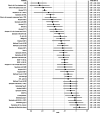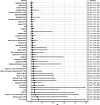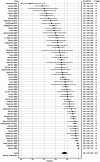Efficacy of interventions for myopia control in children: A systematic review with network meta-analyses
- PMID: 40219611
- PMCID: PMC12604458
- DOI: 10.1111/aos.17496
Efficacy of interventions for myopia control in children: A systematic review with network meta-analyses
Abstract
To determine the effectiveness of various interventions in reducing myopia progression in children. Literature databases were searched on December 2, 2023: PubMed, Embase, the Cochrane Central, Web of Science Core Collection, BIOSIS Previews, Current Contents Connect, Data Citation Index, Derwent Innovations Index, KCI-Korean Journal Database, Preprint Citation Index, ProQuest™ Dissertations and Theses Citation Index and SciELO Citation Index. PRISMA guidelines and the Cochrane Handbook recommendations were followed. All unique interventions were analyzed individually in order to generate clinically applicable results. The main outcome was axial length progression. Secondary outcomes were incident corneal infiltrates, photophobia, development of an allergic response towards the intervention, visual acuity at near and distance and drop-out from allocated intervention/control. We identified 74 RCTs involving 12 154 participants aged 6-18 years. Network meta-analysis compared axial length after 1 year between 45 interventions and placebo or single-vision spectacles. The most effective interventions reported in weighted mean difference and 95% confidence interval were low-level red-light (-0.33 mm (-0.40, -0.25)), ortho-K with 5 mm treatment zone (-0.32 mm (-0.41, -0.24)), ortho-K with aspheric base curve (-0.29 mm (-0.37, -0.22)), atropine 1.0% (-0.28 mm (-0.30, -0.26)), combined atropine 0.01% and ortho-K (-0.24 mm (-0.37, -0.11)), spectacles with highly aspherical lenslets (-0.23 mm (-0.26, -0.19)), ortho-K with increased compression factor (-0.23 mm (-0.28, -0.17), atropine 0.05% (-0.21 mm (-0.30, -0.13)) and defocus incorporated multiple segments spectacles (-0.21 mm (-0.27, -0.15)). Photophobia and reduced near-visual acuity were reported for atropine, and lower adherence to treatment was found for atropine at 1.0%. There was no significant association between any interventions and corneal infiltrates or allergic reactions. Over 70% of the studies were conducted in Asian populations. This systematic review and network meta-analysis highlights the efficacy of various interventions, including orthokeratology lenses, atropine, highly aspherical lenslets and defocus incorporated multiple segments spectacles in slowing axial elongation in children. Low-level red-light therapy also slowed axial length progression, but further research is needed to assess the potential side effects. Future studies should include diverse populations and standardized methodologies to enhance the applicability and comparability of results.
Keywords: axial length; efficacy comparison; myopia control; network meta‐analysis.
© 2025 The Author(s). Acta Ophthalmologica published by John Wiley & Sons Ltd on behalf of Acta Ophthalmologica Scandinavica Foundation.
Conflict of interest statement
Author Y.S. declares to have received a speaker fee for lectures from Bayer and Roche, not related to this study. Remaining authors declare no potential conflicts of interest.
Figures











References
-
- Bao, J. , Huang, Y. , Li, X. , Yang, A. , Zhou, F. , Wu, J. et al. (2022) Spectacle lenses with aspherical lenslets for myopia control vs single‐vision spectacle lenses: a randomized clinical trial. JAMA Ophthalmology, 140(5), 472–478. Available from: 10.1001/jamaophthalmol.2022.0401 - DOI - PMC - PubMed
Publication types
MeSH terms
Substances
Grants and funding
LinkOut - more resources
Full Text Sources
Medical

